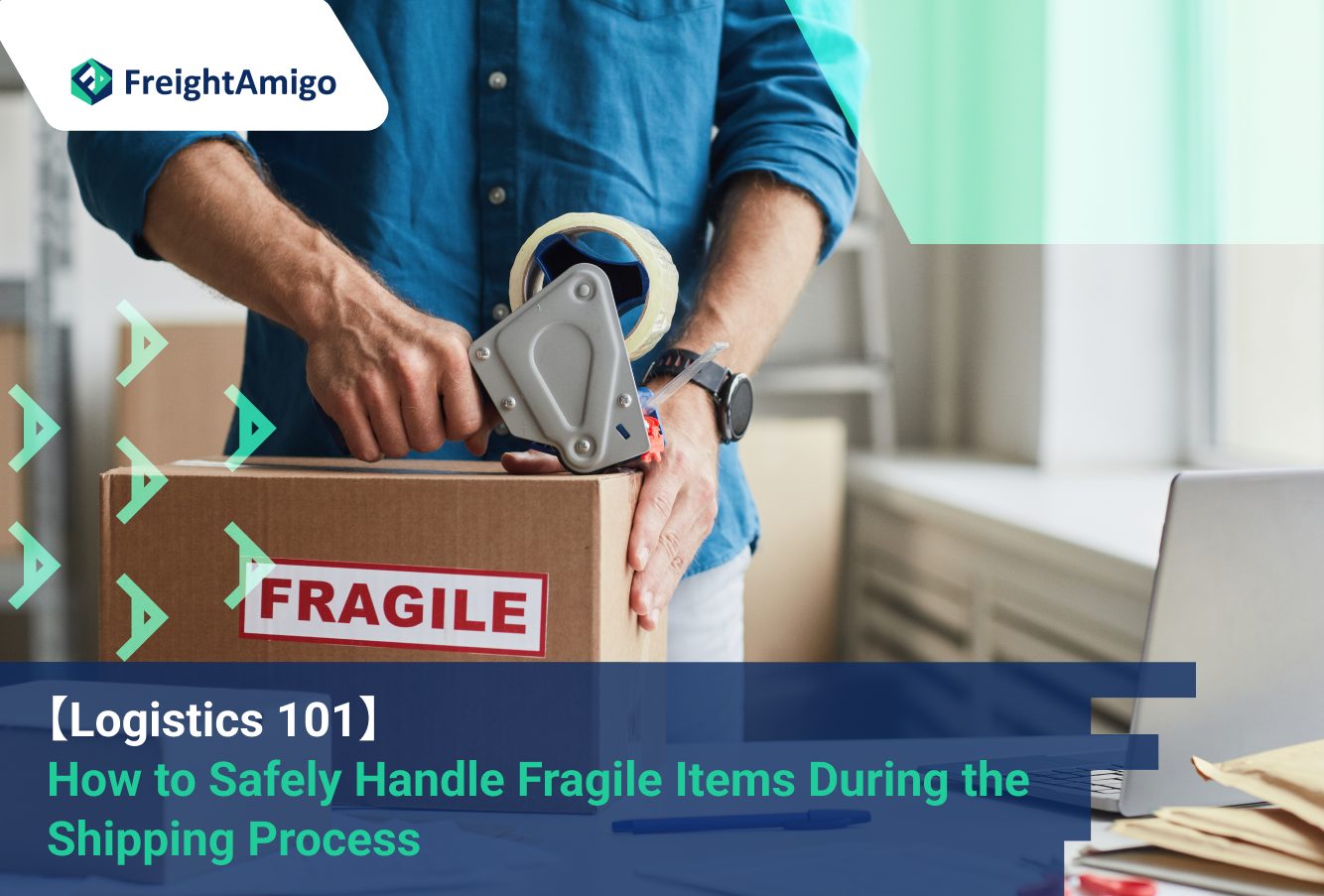Latest update on 28 February, 2024 by Maya Wong – Marketing Analyst at FreightAmigo
Handling fragile items during the shipping process requires special care and attention to ensure that they arrive safely at their destination. Whether you are running an e-commerce business or simply need to ship a delicate one-off item, it is crucial to understand the proper techniques and precautions involved. In this comprehensive guide, we will explore the best practices for handling fragile items, including manual handling techniques, equipment usage, and team training.
Introduction
Shipping fragile items can be a nerve-wracking process, as the risk of damage during transit is a constant concern. However, with proper handling techniques and precautions in place, you can significantly minimize the chances of breakage and ensure that your fragile items arrive safely at their destination. In the following sections, we will delve into the various aspects of handling fragile items during the shipping process, providing you with valuable insights and practical tips.
Want to compare the best Express, Air Freight, Sea Freight, Rail Freight & Trucking rates so as to have better control on cost?
Understanding Fragile Items
Before we discuss the best practices for handling fragile items, it is essential to understand what constitutes a fragile item. Fragile items are those that require extra care and attention due to their delicate nature or high value. This can include items such as glassware, musical instruments, antiques, electronics, and artwork. It is crucial to identify these items accurately and treat them with the utmost care throughout the shipping process.
Proper Packing Techniques
Proper packing is the foundation of safe shipping for fragile items. When packing fragile items, it is crucial to ensure that they are adequately protected and secured within their packaging. Here are some essential packing techniques to follow:
Choose the Right Box Size
Select a box that provides enough space for the item and allows for proper padding. Avoid using a box that is too small, as it may not provide adequate protection.
Use Protective Padding
Wrap the fragile item in bubble wrap or other cushioning materials to provide an extra layer of protection. Fill any empty spaces in the box with packing peanuts or crumpled paper to prevent movement during transit.
Reinforce the Box
Seal the box with high-quality packing tape, ensuring that all seams are securely closed. Use the H-taping method, where you run tape along the corners of the box and a solid piece of tape along the middle, creating an H-shape, to provide extra reinforcement.
Label the Box as Fragile
Clearly label the box as “Fragile” to alert handlers and shippers to exercise caution while handling the package. Consider using additional labels or stickers specifically designed for fragile items.
Choosing the Right Packaging Materials
Selecting the appropriate packaging materials is crucial for ensuring the safety of fragile items during shipping. Here are some essential materials to consider:
Rigid Boxes or Outer Shells
Choose boxes that are sturdy and rigid, providing a protective exterior for the fragile item. Avoid using boxes that are weak or damaged, as they may compromise the safety of the item.
Bubble Wrap or Foam Inserts
Wrap fragile items in bubble wrap or foam inserts to provide cushioning and absorb shocks during transit. These materials create a protective barrier between the item and the packaging.
Packing Nuts or Peanuts
Use packing nuts or peanuts to fill empty spaces within the packaging. These lightweight materials help prevent movement and provide additional protection for fragile items.
Strong Tape and Shipping Labels
Ensure that you have high-quality packing tape to seal the box securely. Use shipping labels to provide clear instructions and information about the package, including the destination address and any special handling requirements.
Manual Handling Precautions
Proper manual handling techniques are essential when dealing with fragile items during the shipping process. Here are some precautions to follow:
Lift with Care
When lifting fragile items, always use proper lifting techniques. Bend your knees and lift with your legs, keeping your back straight. Avoid twisting or jerking motions that could cause damage to the item.
Use Teamwork
For larger or heavier fragile items, enlist the help of a colleague or team member. Working together can make it easier to maneuver and transport the item safely.
Clear Pathways
Ensure that the pathways and work areas are clear of any obstacles or hazards that could lead to accidents or damage to the fragile item. Clearing the way will help minimize the risk of tripping or dropping the item.
Avoid Rushing
Take your time when handling fragile items. Rushing can lead to careless mistakes and accidents. Prioritize safety and ensure that each step of the handling process is executed carefully.
The Importance of Proper Labeling
Proper labeling is crucial when handling fragile items during the shipping process. Here are some key considerations:
Fragile Stickers and Labels
Affix clearly visible and durable fragile stickers or labels to the packaging of fragile items. These labels serve as a visual reminder to handlers and shippers to exercise caution during the shipping process.
Directional Arrows
If there are specific orientation requirements for fragile items, use directional arrows to indicate the correct position in which the item should be handled or stored. This ensures that the item is not inadvertently mishandled.
Destination Labels
Ensure that the destination address is clearly labeled on all sides of the packaging. This helps ensure that the fragile item reaches the intended recipient without any delays or mix-ups.
Special Handling Instructions
In cases where additional precautions or handling instructions are necessary, include clear and concise instructions on the packaging. This can include instructions to keep the package upright, avoid exposure to extreme temperatures, or any other specific requirements.
Collaborating with Shipping Partners
Collaborating with reliable shipping partners is crucial for the safe handling of fragile items. Here are some important considerations:
Research and Choose Trusted Partners
Conduct thorough research and choose shipping partners with a proven track record of handling fragile items efficiently and safely. Read reviews and seek recommendations from other businesses or individuals who have had positive experiences.
Communicate Special Requirements
Clearly communicate any special requirements or handling instructions to the shipping partner. Provide detailed information about the fragile nature of the items and any specific precautions that need to be taken.
Insurance and Tracking
Consider opting for shipping insurance to protect the value of fragile items in case of loss or damage during transit. Additionally, choose shipping options that provide tracking capabilities, allowing you to monitor the progress of the shipment.
Regular Evaluations
Regularly evaluate the performance of your shipping partners to ensure that they continue to meet your expectations in terms of safe handling and timely delivery of fragile items. Address any concerns or issues promptly.
Technology Solutions for Fragile Item Handling
Leveraging technology can significantly enhance the safe handling of fragile items during the shipping process. Here are some technology solutions to consider:
Tracking and Monitoring Systems
Implement tracking and monitoring systems that allow you to track the location and condition of fragile items in real-time. This enables you to identify any potential issues or delays and take proactive measures.
IoT-enabled Packaging
Utilize IoT-enabled packaging solutions that provide real-time data on the condition and handling of fragile items. These smart packaging solutions can detect impacts, temperature fluctuations, and other environmental factors that may affect the item’s integrity.
Automated Handling Equipment
Invest in automated handling equipment, such as robotic arms or conveyor systems, that can handle fragile items with precision and care. These automated solutions minimize the risk of human error and ensure consistent handling practices.
Data Analytics and Predictive Maintenance
Utilize data analytics to identify patterns and trends related to the safe handling of fragile items. Implement predictive maintenance strategies to proactively address any potential issues with handling equipment or processes.
Conclusion
Handling fragile items during the shipping process requires attention to detail, proper techniques, and collaboration with trusted partners. By following the best practices outlined in this guide, you can significantly minimize the risk of damage and ensure that fragile items arrive safely at their destination. Embrace technology, invest in training, and prioritize customer satisfaction to establish yourself as a leader in the safe handling of fragile items during shipping.
Remember, the proper handling of fragile items not only protects your reputation but also contributes to the overall success of your business. By prioritizing the safety of fragile items, you can provide your customers with a positive experience and build long-lasting relationships based on trust and reliability.
Now, it’s time to apply these best practices and revolutionize the way you handle fragile items during the shipping process. Safeguard your delicate items and deliver them to your customers with confidence and peace of mind.
For dependable fragile items shipping, consult logistics experts like FreightAmigo. Visit the FreightAmigo website to inquire about our secure and specialized shipping services for preserving fragile items.
Read More:
【Fine Art Shipping Insurance】 Mitigating Risks and Ensuring Security
【Fragile and High-Value Shipments】 The Importance of Insurance Coverage
【Unveiling the Maze of Vase Shipment】 Navigating the Complexities of International Shipping
If you have any inquiries on logistics/supply chain, feel free to contact FreightAmigo now:
Chat with us online | Hotline: +852 28121686 | WhatsApp: +852 27467829









































